
Alphonse Pénaud, (1850 - 1880)
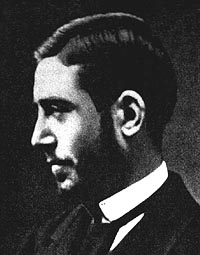 Alphonse Pénaud
Alphonse Pénaudhttp://www.uh.edu Alphonse Pénaud was born in 1850 in Paris. Pénaud planned to join the Navy. Then he suffered a disabling illness. ....So he turned to inventing a flying machine. He was no idle dreamer. He worked methodically. He thought through questions of stability and propulsion. Pénaud was 21 when he finally perfected a rubber-band-driven model airplane. It had a wing, a tail, and a propeller in the rear. It was very close to the models kids like me were building 70 years later. He flew it in the Tuileries Gardens for all to see.
In 1875, the French Academy of Sciences awarded him a prize for his brilliant thinking. Still, Pénaud meant to fly, not just to think. He went to work with a mechanic named Paul Gauchot. In 1876, they patented a full-scale airplane. For the next four years, he looked for the means to build and fly the machine. Long before, when Pénaud was only two, another French inventor, Henri Giffard, had made the first successful dirigible flight over Paris. In 1880 Pénaud turned to Giffard for support in getting a heavier-than-air craft built. Giffard gave him a cold shoulder. Pénaud didn't have the emotional resources to handle that defeat. He went home and built a small wooden casket. He put all his designs into it and delivered it to Giffard's house. Then he went home and committed suicide. He was only thirty and he didn't know that Giffard was also depressive -- that, two years later, Giffard would also commit suicide. But the fierce intelligence of Pénaud's work went on to touch every would-be airplane builder from then until we got it right. Read any book on the history of flight and Pénaud is there as a recurring footnote. In 1874 Bishop Milton Wright bought one of Pénaud's toy helicopters. He took it home to his boys, Orville and Wilbur. And, right there, Pénaud changed the course of history.
Progress in Flying Machines The next experiment to be mentioned was important and quite successful upon the small scale on which it was tried. Fig. 53 represents an aeroplane with automatic equilibrium, produced in 1871 by M. A. Pénaud who called it his "planophore," and whose artificial bird and flying screw have already been noticed. Pénaud flew his Planaphore in the Tuileries Gardens in Paris on August 18, 1871. The Planaphore, a 20-inch long tandem monoplane with a pusher propeller powered by a rubber band flew 131 feet in 11 seconds - this is regarded as first flight of an inherently stable aircraft
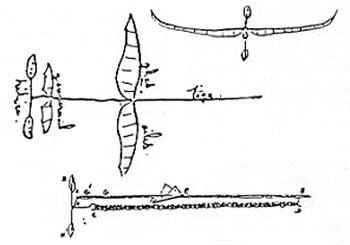 Pénaud's Planaphor(e) of 1871, preliminary sketches?
The motive power in this aeroplane was, as in his former models, the force of twisted india-rubber threads, fastened to a stick 20 in. long, and rotating a double_vaned screw 8 in. in diameter. The aeroplane, 18 in. across, by a width of 4 in., was fastened to the main stick at about its center, so that, through the leverage of the from end, the center of gravity of the apparatus should be slightly in front of the center of surface of the sustaining aeroplane. The outer ends of the latter were bent upward, so as to furnish lateral stability by a diedral angle, and the longitudinal stability was secured by fastening to the main stick back of the aeroplane, as shown, a small pair of wings or rudders, set at an angle of about 8 pointing below the horizon of the main aeroplane.
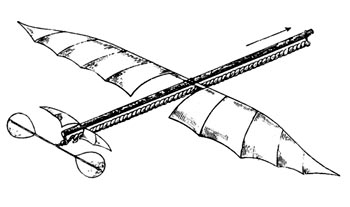 Pénaud's Planaphor(e) of 1871 Download a 1000pixel image
This was the important feature of the apparatus, and M. Pénaud not only showed experimentally that it furnished automatic equilibrium, but he also demonstrated26 the mathematical reasons why it should do so, in reestablishing, through the action of the air impinging upon this horizontal rudder set at a fixed angle, any deviation of the aeroplane from the horizontal line of flight. The principle is the same as that of the rear told of the paper aeroplane which has already been described, and the following account of its mode of action was given by Mr. Bennett at the 1874 meeting of the Aeronautical Society of Great Britain:
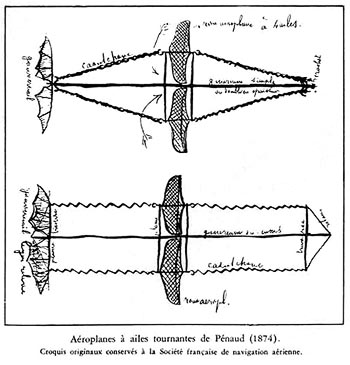 Pénaud - sketch plan for a rubber powered device c.1870 Download 500pixel image [300dpi]
The center of gravity of he machine is placed a little in front of the center of pressure of the aeroplane, so that it tends to make the model descend an incline; but in so doing it lessens the angle of inclination of the aeroplane, and the speed is increased At the same time the angle of the horizontal rudder is increased, and the pressure of the air on its upper surface causes it to descend; but as the machine tends to turn round its center of gravity, the front part is raised and brought back to the horizontal position. If, owing to the momentum gained during the descent, the machine still tends upward, the angle of the plane is increased, and the speed decreased. The angle of the rudder from the horizontal being reduced, it no longer receives the pressure of air on its superior surface, the weight in front reasserts its power, and the machine descends. Thus, by the alternate action of the weight in front and the rudder behind the plane, the equilibrium is maintained. The machine during flight, owing to the above causes, describes a series of ascents and descents after the manner of a sparrow. The weight of the entire apparatus was 0.56 oz., of which the rubber absorbed 0.17 oz., or about one-third. The surface was 0.53 sq. ft., so that the proportion was nearly at the rate of 15 sq. ft. per pound, and necessarily gave a slow flight. The apparatus was publicly exhibited in August, 1871, to a group of members of the French Society of Aerial Navigation, in the garden of the Tuileries, and the model, guided horizontally by a small vertical rudder, not shown on the figure, flew several times in a circle, falling gently to the ground near its starting-point, when the power of the rubber was exhausted. The speed was not quite 12 ft. per second, or about the same as that of insects with the same relative surface in proportion to their weight, and the flight was 131 ft. in 11 seconds, with 240 turns of the rubber. Subsequently M. Pénaud measured the power consumed in a very ingenious way. He found that with 60 turns of the rubber the apparatus would just hold its own--i.e., hover in the same spot, against a wind of 9 ft. per ,second, and knowing the speed of rotation of the screw, as well as the weight of the apparatus, he deduced the conclusion that the power expended was at the rate of one horse-power for each 81 lbs. of weight, although M. Touche, who has revised the calculations, makes it about three times this amount--a result, of course, quite inferior to those obtained by Professor Langley and by Mr. Maxim, because, perhaps, of the greater proportion of surface to weight.
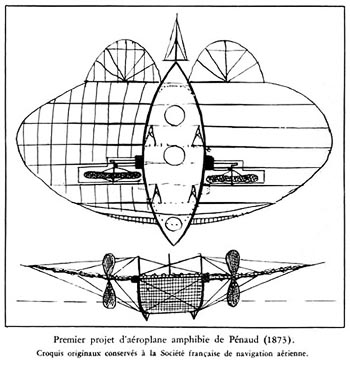 Pénaud Seaplane design of 1873 Download 500pixel image [300dpi]
M. Pénaud was a very ingenious man, and might have accomplished great things in aerial navigation had not his career been cut short prematurely. He was one of the few men who have taken up the subject in his youth, for it is a singular fact that most of the scientific students of this inchoate research are now men of middle age, perhaps past the dread of being considered mentally unsound, but no longer with the ardor and the daring of youth. M. Pénaud however, began before he was 20 years old, by producing his flying screw. He had intended to enter the French Navy, but a painful hip disease had brought him to crutches, and left him no career but that of scientific studies. These he directed to aerial navigation, and during six or seven years of improved health he impetuously investigated and experimented upon the various phases of the problem. Not only did he produce the three forms of apparatus which have been described, almost the first which have practically worked, each flying upon a different principle and all produced by one man, but he took a very active part in the investigations promoted by the French Society for Aerial Navigation; making a scientific balloon ascent, in which he was somewhat injured. designing a plane table for platting the course of balloons, a guide rope break, a delicate barometer, a balloon-valve, a kite without a tail, balanced in the same way as his aeroplane, a form of explosion engine, a programme for experiments on air resistances, one for investigation of flight by instantaneous photography, since--carried out by Professor Marey, etc., etc., towering above his fellow-members in discussions, in a way which must have excited many jealousies; and he also contributed a number of very valuable papers to the Aéronaute in one of which he endeavored to account for the mystery of sailing flight by showing that ascending currents in the wind were not rare, and were quite sufficient to explain all the phenomena. These labors finally culminated in his taking, in 1876 (in partnership with M. Gauchot a clever mechanician, who had produced an artificial bird), a patent for the apparatus shown in fig. 54, which was to be of sufficient size to carry up two men.
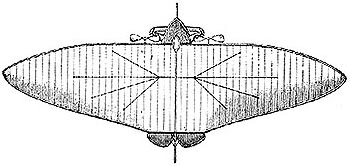 The Pénaud - Gauchot design of 1876 - sketch plan
It was to consist of an aeroplane somewhat in the form of an ellipse, built of a light framework covered both at top and bottom with varnished silk, and stiffened by wire stays radiating from two short masts above and from the car below the aeroplane. The outer ends of the aeroplane were to be flexible, or to be set at a diedral angle, in order to produce lateral stability, and the rear portion was also to be flexible and to bend upward, to produce the longitudinal stability, this being, moreover, provided for by two horizontal rudders, side by side, hinged at the rear, so as to set themselves automatically at the angle required to produce fore-and-aft equilibrium, upon the principle developed in the "planophore." Under these balanced horizontal rudders a vertical rudder was to steer to the right or left. A car, in the shape of a light boat, was to be rigidly attached just under the aeroplane, the steersman standing or sitting at the bow, with his head just above the top of the aeroplane, and protected from the wind by a glass box. Movable legs with rollers and springs were to be let down to get a preliminary run on land, or to alight in a glancing direction.
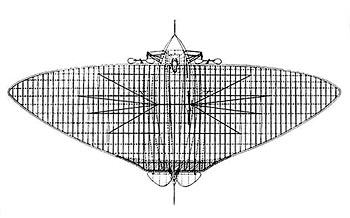 The Pénaud - Gauchot design of 1876 - plan
The motion was to be obtained from two propellers, placed at the front edge of the aeroplane, and rotating in opposite directions; the power to be furnished by a steam engine--although M. Pénaud said frankly that he knew of none in practical operation sufficiently light for his purpose. He believed it ought not to weigh more than 15 to 22 lbs. per horse-power, and hoped to get one constructed within those limits. The engine was so to be located in the car as to bring the center of gravity of the apparatus one-fifth of the distance back of the front edge, and all the steering was to be done by the helmsman through a single lever, which might either be pulled or pushed to work the horizontal rudders, or twisted to work the vertical rudder.
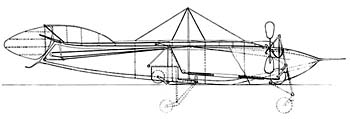 The Pénaud - Gauchot design of 1876 - elevation
The sustaining surface of the aeroplane was to be proportioned at the rate of about 0,24 sq. ft. per pound of weight, the whole apparatus with two aviators was to weigh 2,640 lbs, and required an engine of 20 to 30 H.P. to fly through the air at 60 miles per hour, with an angle of incidence of 2°ree;. This apparatus, the result of several years of study by an able man who bestowed very careful thought thereon, was never built. The writer of this does not believe it would have succeeded if it had been experimented with, but valuable data might have been obtained. Aside from the difficulty about a light motive power, a difficulty now almost removed, it may be questioned whether the general form of the aeroplane was the best possible to glide upon the air, and whether the longitudinal equilibrium would have been as well preserved as in M. Pénaud's toy model. If not, then a sustaining surface of only 0.24 sq. ft. per pound would have been exceedingly dangerous. The horizontal rudders, when left to adjust themselves, were expected to regulate the automatic balance, but they were also expected, when actuated by the steersman, to alter the angle of incidence, .in order to cause the apparatus to rise or to fall. Such a change in the angle would necessarily alter the position of the center of pressure, and there was no provision for making a corresponding change in the center of gravity, other than by the displacement of the aviators themselves, or that of the fuel, water, or boiler, which displacement would be nearly impracticable. This was the weak point, for the pressure being then applied at a point differing from the center of gravity, would act with a leverage upon the apparatus and tilt it either forward or backward longitudinally, so that, had it been experimented with on a practical scale, it might have experienced a forward sheer or a plunge, either from too great an action of the horizontal rudders in rising or in coming down, or, as in the case of poor Le Bris's second experiment, from encounter with a stratum of wind of different horizontal direction than that for which the machine was adjusted. Perhaps surmising the possibility of some such action, M. Pénaud suggested that the experiments should be conducted over a sheet of water. The apparatus might also have been suspended between two very high masts, or from a captive balloon, but probably the best results would have been obtained by experimenting entirely clear of any restraining supports. At any rate no funds were forthcoming for the construction of the full-sized machine. M. Pénaud was criticised decried, misrepresented, and all sorts of obstacles arose to prevent the testing of his project. He lost courage and hope, his health gave way, and he died in October, 1880 before he had reached 30 years of age.
Pénaud's Earlier devices
M. de la Landelle ... encouraged M. Pénaud, then a rising young man, to take up the study of Aviation. The latter produced in 1870 the little apparatus shown in fig. 29, which has remained the best of its kind.
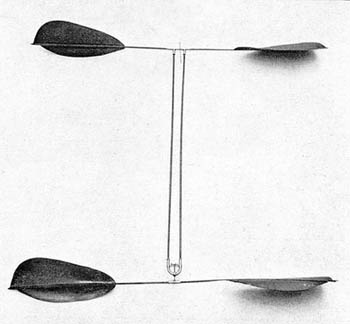 Pénaud's Screw, 1870 Height: 28 centimeters. Diameter: 31 centimeters. Weight: 6 grams. Disregarding the strange shape of this machine, we must remember its extraordinary qualities in the year 1870. Musée de l'Air Collection
Pénaud's flying screw, which is called by the French a "Helicoptère," consists of two superposed screws rotating in opposite directions, and actuated by the force of twisted rubber strings. The principle is the same as the apparatus of Launoy & Bienvenu and of Sir George Cayley, but the twisted rubber is far more effective than the bow, whether the latter be of whalebone or steel, and this change in the motor constituted the chief merit of Pénaud's modification. He first experimented with rubber in tension, but found that the increased weight of the frame (to resist the strains) more than compensated for the weaker effects of torsion, and that the latter application enabled him to construct models which were simple, cheap, efficacious, and not easily broken.
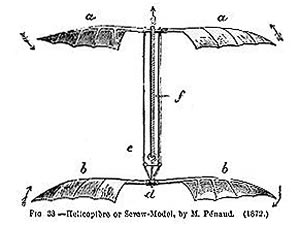 Pénaud's Screw c.1870 Encyclopedia Britannica, c,1875
These models, when built in varying proportions, would either rise like a dart to a height of some 50 ft., and then fall down, or sail obliquely in great circles, or, after rising some 20 or 25 ft., hover in the same spot for 15 or 20 seconds, and sometimes as many as 26 seconds, which was a much longer flight than had ever before been obtained with screws. For lack of a sufficiently light primary motor, Pénaud's further experiments in this direction brought forth no practical results, and his apparatus has remained a toy, which has been varied in many ways.
Pénaud's Ornithopter of 1872 In 1872 Pénaud who had already succeeded (1870 and 1871) in compassing flight with the superposed screws and with the aeroplane, which will be noticed hereafter, by the force of twisted rubber, applied the same motor to a mechanical bird, which is shown in fig. 17. The wings beat straight down, and the propulsion is obtained from the flexion of their outer edges produced by the reaction of the air.
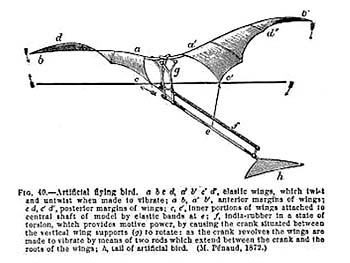 Pénaud's Ornithopter of 1872 Encyclopedia Britannica, c,1875
The bird is unable to rise from the ground, but upon being thrown off the hand it first descends some 2 ft., and then, having acquired the initial velocity needed for support, it flies for a distance of 50 ft. in 7 seconds, rising at the same time about 8 or 9 ft. above the point of departure, the equilibrium being perfectly maintained by the tail.
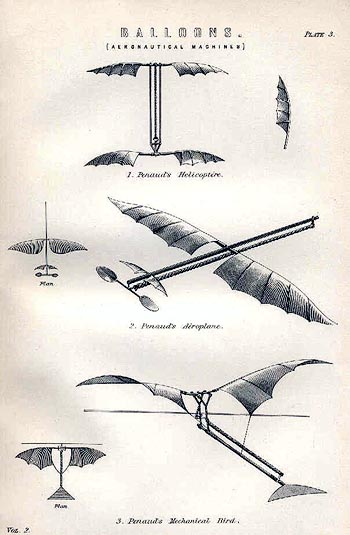 Pénaud's designs of of 1871/72 Encyclopedia Britannica?, c,1875
Simultaneously with this M. Hureau de Villeneuve, the permanent Secretary of the French Aeronautical Society, brought out his mechanical bird, which is shown in fig. 18. In this the plane of the wings is inclined at an angle of 45°ree;, and the power is obtained from twisted rubber. In consequence of the peculiar motion of the wings, this model was able to start direct from the ground, but owing to the limited power of the rubber spring it only rose to the height of 4 ft., and then descended, forming a parachute. It was subsequently modified so that it would fly horizontally for a distance of 24 ft., at a velocity of 20 miles per hour. and finally? and advertisement for a 'contemporary' ornithopter
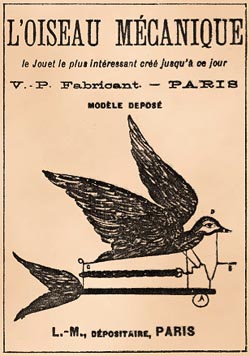 Pichancourt ornithopter advertisement, c.1879 http://indev.hypermart.net/wallpaper.html
Further Reading
Pénaud, Alphonse, Recherches sur la Resistance de l'Air, 1878
|
© Copyright 1999-2002 CTIE - All Rights Reserved - Caution |